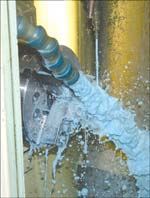Coolant Change Eliminates Foul Odors
Coolants are often problematic for many companies, even in cooler environments. For companies situated in warm, humid climates, problems with sump life, coolant odor, dermatitis and rust can be especially difficult to combat.
Micro Metals (Jamestown, Tennessee) is located in the heart of the industrial south. The company specializes in high-density structural parts, and it has combined responsive engineering and quality assurance standards to meet exacting customer requirements.
Coolants are often problematic for many companies, even in cooler environments. For companies situated in warm, humid climates, problems with sump life, coolant odor, dermatitis and rust can be especially difficult to combat. Like other shops, Micro Metals prides itself on not only creating quality parts for customers, but also on maintaining a quality environment for employees. However, despite good coolant management practices, the company has experienced coolant issues. When the coolant odor became an almost daily problem, the company increased its concentrations. But as a result, there were outbreaks of dermatitis. According to Lenor Blair, supervisor, the odor became so severe that the staff had to constantly dump coolant, sometimes every week.
"No matter how often we changed the coolant, the odor got progressively worse," comments Mr. Blair.
Mr. Blair decided to contact Dyna Tech (Pewaukee, Wisconsin) to examine ways to alleviate the coolant issues. It was then determined that Dyna Cool K2202 would be the company's best plan of action. This type of cutting fluid is said to be high performance, formulated with components resistant to bacteria growth, yet gentle to the operator. Although it is semi-synthetic, the product has high oil content for better lubricity, extended tool life and rust protection, the manufacturer says. The high oil content leaves a protective film to prevent rust during shutdown periods, an important consideration for CNC machines. These qualities, in addition to its low foaming action, made Dyna Cool K2002 appropriate for use on Micro Metals' machines.
The company chose to first clean its machines with Dyna Clean Bio 90, a non-hazardous cleaner, because of the severity of the odor problems. After the clean-out, the worst-smelling machine was replenished with the new coolant.
"The operators noticed right away that the coolant didn't smell bad anymore," Mr. Blair says. He also observed that the dermatitis complaints went away and tool life began to increase.
After this success, shop management decided to use the cutting fluid throughout the plant. Since that time, dermatitis complaints have completely disappeared, and Micro Metals no longer battles with coolant odor. Mr. Blair says the shop tries to keep the coolant as clean as possible, but this is challenging in a high-production shop. A simple proportioning system has been implemented to ensure that adequate concentration is maintained in the machines. Concentrations are monitored with a refractometer on a routine basis. Because the cutting fluid is very forgiving, a wide concentration range and a bit of tramp oil can be tolerated without spoiling.
Almost a year has passed since the switch to Dyna Cool. Micro Metals has improved the plant environment considerably by finding an economical solution to difficulties such as coolant odor, rust and dermatitis. The company is also experiencing unexpected advantages—reduced costs and improved sump life.
Related Content
-
Unist's Electronic Control Regulates Lubricant Delivery
Unist’s Pulse R electronic control ties into the system control solenoid valve and takes the place of a pneumatic pulse generator timer or logic block.
-
STLE To Host Metalworking Fluid Management Program
STLE’s program is a two-and-a-half-day education program offering a comprehensive overview of metalworking fluid management.
-
Jorgensen's Coolant Collection System Eliminates Sludge Build-Up
The PermaClean system adds agitation to the coolant collection system or holding tank and prevents particulates from settling.









.png;maxWidth=300;quality=90)







